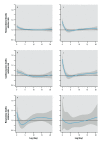Assessment of Short- and Long-Term Mortality Displacement in Heat-Related Deaths in Brisbane, Australia, 1996-2004
- PMID: 25794410
- PMCID: PMC4529002
- DOI: 10.1289/ehp.1307606
Assessment of Short- and Long-Term Mortality Displacement in Heat-Related Deaths in Brisbane, Australia, 1996-2004
Abstract
Background: Mortality displacement (or "harvesting") has been identified as a key issue in the assessment of the temperature-mortality relationship. However, only a few studies have addressed the "harvesting" issue and findings have not been consistent.
Objectives: We examined the potential impact of both short- and long-term harvesting effects on heat-related deaths in Brisbane, Australia.
Methods: We collected data on daily counts of deaths (nonaccidental, cardiovascular, and respiratory), weather, and air pollution in Brisbane from 1 January 1996 to 30 November 2004. We estimated heat-related deaths, identified potential short-term mortality displacement, and assessed how and to what extent the impact of summer temperature on mortality was modified by mortality in the previous winter using a Poisson time-series regression combined with distributed lag nonlinear model (DLNM).
Results: There were significant associations between temperature and each mortality outcome in summer. We found evidence of short-term mortality displacement for respiratory mortality, and evidence of longer-term mortality displacement for nonaccidental and cardiovascular mortality when the preceding winter's mortality was low. The estimated heat effect on mortality was generally stronger when the preceding winter mortality level was low. For example, we estimated a 22% increase in nonaccidental mortality (95% CI: 14, 30) with a 1°C increase in mean temperature above a 28°C threshold in summers that followed a winter with low mortality, compared with 12% (95% CI: 7, 17) following a winter with high mortality. The short- and long-term mortality displacement appeared to jointly influence the assessment of heat-related deaths.
Conclusions: We found evidence of both short- and long-term harvesting effects on heat-related mortality in Brisbane, Australia. Our finding may clarify temperature-related health risks and inform effective public health interventions to manage the health impacts of climate change.
Conflict of interest statement
The authors declare they have no actual or potential competing financial interests.
Figures




References
-
- Australia Bureau of Statistics. 32180 Regional Population Growth, Australia. 2012. Available: nsf/DetailsPage/3218.02012?OpenDocument [accessed 18 August 2013]
-
- Baccini M, Biggeri A, Accetta G, Kosatsky T, Katsouyanni K, Analitis A, et al. Heat effects on mortality in 15 European cities. Epidemiology. 2008;19(5):711–719. - PubMed
-
- Basu R, Malig B. High ambient temperature and mortality in California: exploring the roles of age, disease, and mortality displacement. Environ Res. 2011;111(8):1286–1292. - PubMed
-
- Braga AL, Zanobetti A, Schwartz J. The time course of weather-related deaths. Epidemiology. 2001;12(6):662–667. - PubMed
-
- Davis RE, Knappenberger PC, Michaels PJ, Novicoff WM. Seasonality of climate–human mortality relationships in US cities and impacts of climate change. Clim Res. 2004;26(1):61–76.
Publication types
MeSH terms
LinkOut - more resources
Full Text Sources
Other Literature Sources

